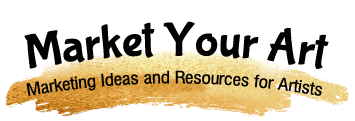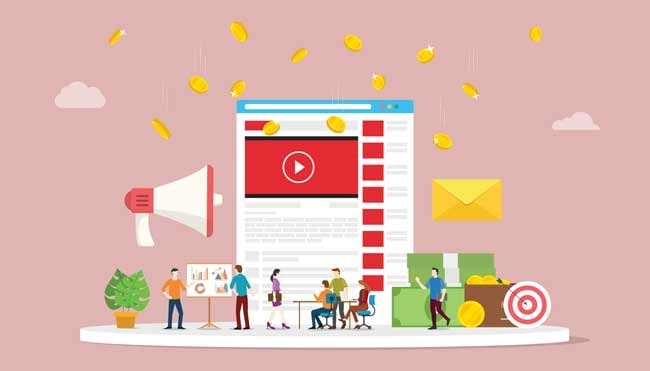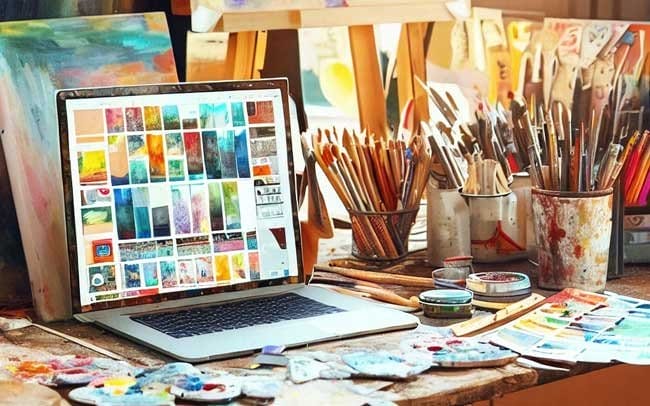Many people associate LinkedIn with corporate professionals, job recruiters, or business networking. It’s time to move past this perception and explore the vibrant opportunities that LinkedIn can offer artists.

LinkedIn, at its core, is a networking platform. For artists, this means a wealth of connections at your fingertips. Imagine being able to connect with gallery owners across the globe, fellow artists, art educators, and even potential clients looking for commission work. Through LinkedIn, you can establish relationships with people who appreciate and support art, fostering valuable connections that might lead to future collaborations or opportunities.
Building a Professional Brand
As an artist, you are your own brand. LinkedIn for Artists allows you to present your professional self to the world in a polished, comprehensive manner. This is more than just a place to list your resume—it’s a platform where you can weave the narrative of who you are as an artist. Showcase your experiences, exhibitions, awards, and education in a neat, organized profile that effectively communicates your artistic journey and current ventures.
Industry Insights and Trends
Staying updated with the latest art trends, gallery openings, and industry news is essential for an artist. LinkedIn can be your window into this world. By following influential art professionals, galleries, and organizations, you receive a curated feed of industry-specific content. This enables you to stay informed and inspired, and even participate in meaningful discussions with others who share your passion for art.

LinkedIn Features
| 1. Primarily for professional networking |
| 2. Focus on industry insights and business content |
| 3. Offers a platform for job postings and career opportunities |
| 4. Encourages endorsements and professional recommendations |
| 5. More formal tone and content presentation |
| 6. Allows users to create a personal profile |
| 7. Enables users to connect with others (friends, colleagues) |
| 8. Facilitates sharing of content (posts, images, videos) |
| 9. Provides options to like, comment on, and share posts |
| 10. Offers private messaging features |
By embracing LinkedIn, artists can unlock a multitude of opportunities beyond the canvas or studio, stepping into a space where creativity meets professional networking. It’s not just for the suit-and-tie crowd; LinkedIn is a gallery, a stage, and a networking event, all rolled into one digital platform. And it’s waiting for artists like you to seize its potential.
1. Setting Up a Standout Artist Profile
Your LinkedIn profile is more than just a digital resume; it’s your online art portfolio and your professional brand rolled into one. Let’s explore how to effectively set it up.
Create a Standout Profile: Treat it as an Artist’s CV
Start with a compelling profile picture – one where your personality shines. Follow this with a banner image that showcases your art. Your headline should not just be your title; it should capture your essence as an artist. For example, instead of “Freelance Artist”, consider “Visual Storyteller Specializing in Watercolor Landscapes”.
In the summary section, tell your story. This isn’t a list of jobs but a cohesive narrative. Discuss what drives your artistry and what themes you love to explore in your work.
Example:
“I am a painter inspired by the natural world, committed to capturing the serene beauty of coastal life.”
Showcasing Different Styles and Media: Highlight the Range of Your Abilities
Under the ‘Featured’ section, display diverse examples of your work. If you are a painter who also dabbles in sculpture, show both. Include high-quality images, and if possible, add videos of your process or final pieces in situ.
**[Here is a guide](https://www.website.com/link-to-guide)** on how to take professional photos of your artwork.
Documenting Your Artistic Journey: Using LinkedIn as a Visual Journal
Chronicle your growth and milestones in the ‘Experience’ section, not just jobs but exhibitions, significant projects, and residencies.
Example:
“2023 Solo Exhibition at Capital City Art Gallery“
Check out this video on How to create a PROFESSIONAL LinkedIn Profile
Creating a standout LinkedIn profile as an artist is akin to preparing for a gallery show. Your profile is your space to shine, tell your story, and exhibit your work. By approaching it with the same care and creativity that you apply to your art, you can construct a LinkedIn presence that resonates with viewers and invites connections, opportunities, and growth.
2. Expanding Your Network and Engaging with Your Audience
Growing a professional network as an artist on LinkedIn involves more than just accumulating connections. It’s about building meaningful relationships that can help propel your career forward. Let’s look at how to expand your network effectively and engage with your audience meaningfully on LinkedIn.

Connect with People You Know
Begin with people you already know— former classmates, colleagues, mentors, and clients. These connections aren’t just numbers; they are your initial audience, likely to appreciate your work and possibly share it with their own networks. They are also the people who might write you a glowing recommendation on your profile, providing social proof of your skills and character.
Reach Out to Potential Clients
Think about who might commission your work and don’t be shy about connecting. Are you a muralist? Local government offices, property developers, or community centers might be in the market for your skills. Or perhaps you create custom illustrations— reach out to authors, publishers, or marketing agencies. When you send a connection request, always include a personalized message. Keep it brief and sincere, expressing your genuine interest in their work.
Engaging with Your Audience
Responding to comments on your posts is just as important as posting your artwork. Thank people for their compliments. If someone asks a question, answer in a friendly and informative manner. Post questions of your own to stimulate conversation, like asking for opinions on a technique or inviting ideas for your next piece.
Moreover, sharing others’ content—whether that’s an interesting article or another artist’s work that you admire—can be a great way to engage with your network. It shows that you are not just here to promote your own work, but you are also an active, interested member of the community.
Building Community
Beyond immediate connections, LinkedIn Groups provide a place for like-minded professionals, including artists, to discuss their craft, share opportunities, and offer advice. Engage in these groups with the same thoughtful, genuine interaction that you use on your profile.
LinkedIn is not a one-way street. It’s a platform for dialogue and interaction. By taking a thoughtful approach to connections, by participating rather than just posting, and by being an active and respectful member of the LinkedIn community, you position yourself not only as an artist but as a valued professional peer. You’re not just building a network; you’re nurturing relationships, and that’s the secret to expanding your career horizons through LinkedIn.
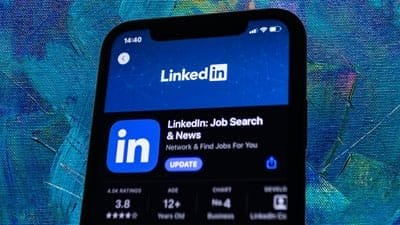
3. Effective Posting Strategies for Art Professionals on LinkedIn
LinkedIn is a professional networking platform, but for artists, it can also be a vibrant online art gallery. It’s a place where the business of art meets creative passion. Let’s explore how artists can use LinkedIn to promote their work effectively.
Think of your profile page as your curated space, akin to a personal exhibition in a gallery. Regularly post images of your recent works, behind-the-scenes looks into your process, and updates about your art business. Share insights or write articles about trends in the art world. This varied content strategy keeps your LinkedIn network engaged and coming back for more.
LinkedIn is a great way to reach the right people — collectors, curators, and fellow artists. Use hashtags related to your medium, style, or the subject of your art. This increases the visibility of your posts to people who follow or search for those hashtags.
Every time you post an artwork, accompany it with an informative caption. Explain the inspiration behind the piece, the techniques used, or the story it tells. This allows potential collectors and other members of your LinkedIn network to connect with your work on a deeper level.
LinkedIn is considered a space for industry knowledge sharing. Regularly post tips or advice for other artists, or write about lessons you’ve learned in managing your art business. This establishes you as a knowledgeable professional in your field.
Join groups that align with your art business, whether they are groups for artists, collectors, curators, or art startup enthusiasts. Participate in discussions, offer your perspective, and get in touch with members whose work or insights resonate with you.
LinkedIn is a professional networking powerhouse, where you can directly get in touch with collectors and curators. Send a personalized connection request or a respectful message to introduce yourself and your work. Remember, LinkedIn is about forming genuine relationships, not just transactional interactions.
Monitor which posts get the most engagement and consider why that might be. Use this data to refine your future posts, ensuring that your time online is spent as effectively as possible.
LinkedIn is more than just a platform for corporate professionals; for artists, it’s a vital tool to promote their work, connect with the right people, and learn more about successful art creation and curation. Approach LinkedIn with the seriousness and strategy you would in running your art business, and you’ll be on the path to success.
4. Collaboration, Partnerships, and Discovering New Opportunities

In the art world, networking can often be as important as the art itself. LinkedIn, as a vast social network, is the perfect platform for artists to begin networking and forge powerful connections. Here’s how to use LinkedIn to add value to your artist’s brand and nurture your artist’s career.
Connecting with Industry Leaders
LinkedIn for Artists allows you to directly connect with industry leaders who may be out of reach on other platforms. If you’re interested in a gallery or an art organization, follow their page. Engage with their posts in a meaningful way, don’t write just for the sake of it. Thoughtful engagement could lead to a professional relationship that changes the trajectory of your artist’s career.
Crafting Your Artist Statement
Your LinkedIn profile should include a well-crafted artist statement. This is an essential aspect of your artist brand. Think of this statement as a concise version of your artistic vision and values. It tells visitors to your profile what you stand for as an artist and what they can expect from your work. It sets the tone for your professional identity.
Building Community with Like-Minded Individuals
Joining groups filled with like-minded individuals is an effective way to expand your circle. Engage in the discussions, share insights, and establish rapport. You aren’t just adding connections; you’re building relationships with people who share your passions and can offer targeted advice.
Adding Value as an Artist
Networking isn’t just about what you can gain—it’s also about what you can offer. Regularly share insights about the art world, tips for other artists, or promote other artists whose work you respect. By consistently adding value to your social network, you become a respected voice in your community.
Integrating LinkedIn into Your Artist’s Marketing Strategy
Utilize LinkedIn as a core part of your artist’s marketing strategy. Use it to announce your upcoming exhibitions, art sales, or notable projects. Share your milestones to keep your network informed and engaged with your artistic journey.
Getting featured in blogs and online magazines can significantly boost an artist’s visibility, and LinkedIn is a powerful tool to make this happen. By using LinkedIn, artists can strategically connect with the editors, writers, and contributors of art blogs and magazines.
After establishing these professional connections, artists can then introduce themselves and their work in a personalized and respectful manner through LinkedIn’s messaging feature. They can share their portfolio and express a genuine interest in having their art featured. Because LinkedIn is designed for professional networking, it offers artists a more formal and credible avenue to approach these publications, increasing the chances of securing those coveted feature opportunities in blogs and online magazines.
5. Leveraging LinkedIn’s Tools for Artists
Being an artist today is about more than creating; it’s about being serious about your business. LinkedIn can be a part of that business plan, offering tools that cater to professionals in every field, including the arts. Some strategies Artists can adopt to leverage LinkedIn’s resources are as follows:
| LinkedIn Premium and its Advantages – Upgrading to LinkedIn Premium is a great opportunity for artists. It comes with a plethora of perks, such as access to industry trends data, case studies, and top-tier courses through LinkedIn Learning. These tools can help artists stay updated with what’s happening in the art-related world, including emerging markets like NFTs. |
| Building a Track Record with Recommendations – Don’t hesitate to ask for and give recommendations on LinkedIn. A recommendation from a well-respected professional can enhance your credibility and establish a solid track record in your profession. It’s a win-win; when you endorse the skills of your contacts, they are likely to return the favor, and this boosts the profiles of both parties involved. |
| Networking Effectively – Start connecting with business professionals who are likely to be interested in your work. Once you’ve engaged with their content and built a rapport, invite them into your network. The goal is not just to grow your connections but to forge meaningful relationships where you could potentially solve their problems with your art, and they can offer affiliations or opportunities that benefit you. |
| Mastering the Art-Related Skills – Through LinkedIn Learning, artists can access thousands of courses to further their artistry or business acumen. Want to learn a lot about how to photograph your work, write grants, or understand the basics of NFTs? This is your resource, and it’s tailored to fit busy schedules. |
| Sharing Your Artistic Journey as a Case Study – Artists can create posts or even write articles that break down a recent project as a case study. This can demonstrate not only your final work but the process, the problem-solving, and the passion that goes into your creations. It can help other artists, appeal to potential clients, and demonstrate that you are serious and successful in your business endeavors. |
6. Maintaining Professionalism While Showcasing Personality
In the vast world of LinkedIn, standing out while maintaining professionalism can be a delicate balance. For artists, LinkedIn is more than a social networking site—it’s a stage on which your professional and creative selves meet.
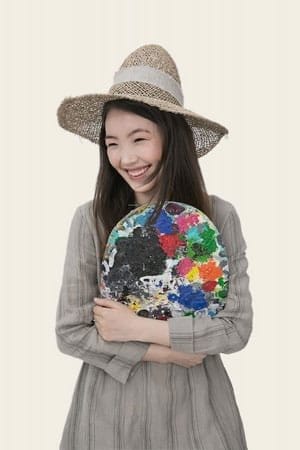
Your LinkedIn profile is your online business card. Starting with your profile photo, make a statement that is professional yet authentically you. Your photo should be clear, high quality, and reflective of your artistic identity. Your headline, summary, and the body of your profile need to make it easy for industry professionals to understand your artistry and your business acumen.
Voice in Your LinkedIn Posts – When crafting LinkedIn posts, your voice should echo the same balance—professional, yet personal and passionate. Share your latest work, yes, but also share what inspired it, the challenges you faced, and your growth from the experience. Don’t shy away from showing enthusiasm for your art; excitement can be contagious and engaging.
When you comment on the posts of industry professionals, it’s important to be respectful and insightful. Acknowledge their ideas, add your perspective, and ask engaging questions, but always with professionalism and courtesy. LinkedIn is a social networking site, but it’s not the place for casual comments you might post on a friend’s Facebook photo.
Handling Criticism Gracefully – Not everyone will understand or appreciate your art, and that’s okay. Should you receive criticism or negative comments on your LinkedIn posts, respond with grace and professionalism. Thank people for their feedback and, if appropriate, use it as an opportunity for a respectful dialogue.
Remember that not everyone viewing your page will be an artist or involved in the arts at all. Use language that is accessible to a wide audience. Make it easy for anyone—be they a fellow artist, a potential client, or someone completely new to the art world—to understand what you do and the value you offer.
7. Setting and Measuring Goals for LinkedIn Success
Setting specific and measurable goals is the foundation of a successful strategy on LinkedIn. This final section provides a guide to setting these goals for your LinkedIn activities, and how to review and adjust your strategy based on performance indicators.
Begin your LinkedIn journey with SMART goals—specific, measurable, achievable, relevant, and time-bound. These goals guide your activities on the platform. For example, set a goal to connect with 20 new industry professionals per month or to share two pieces of your art every week. This brings purpose and focus to your time spent on LinkedIn, steering you towards productive engagement.
Your LinkedIn strategy is not set in stone. Regularly set aside time to evaluate the goals you’ve set. Are you seeing the engagement levels you aimed for? Are you connecting with the kinds of professionals that you aspired to network with? If the answer to these questions is no, it may be time to reassess and adjust your goals. This isn’t a sign of failure, but a natural part of the learning curve.
When you reach a goal, take time to celebrate that success, no matter how small. Acknowledging victories, such as getting a certain number of followers or receiving positive feedback on your art, is vital. These milestones, big or small, are affirmations that your hard work is paying off and are essential for maintaining momentum.
The digital landscape is ever-changing, and LinkedIn is no exception. Stay open to change and be willing to refine your approach based on your experiences and the feedback you receive. Whether that means revising your posting schedule, changing the tone of your communication, or rethinking the types of content you share, flexibility is key.
To truly understand if you’re meeting your goals, you need data. LinkedIn provides robust analytics on your profile’s performance. Regularly check these insights to determine if your strategy is working. This will guide you in making data-driven decisions.
Common Questions about Linkedin for Artists

Q: How can I effectively showcase my art on LinkedIn?
A: Create a comprehensive portfolio in the ‘Featured’ section of your profile. Use high-quality images of your work and include descriptions for each piece. Also, consider publishing posts that highlight recent projects, exhibitions, or creative processes.
Q: Is LinkedIn beneficial for artists, or is it just for corporate professionals?
A: LinkedIn is beneficial for artists as well. It allows you to network with industry professionals, find opportunities (like exhibitions, residencies, or grants), and gain exposure to your art. It’s a powerful platform to showcase your professional journey as an artist.
Q: How do I network with galleries, curators, and other artists on LinkedIn?
A: Start by connecting with people you already know, then gradually extend your network. Engage with others’ content by liking, sharing, and commenting, and regularly post updates about your own work. Join art-related groups on LinkedIn where you can meet and interact with like-minded professionals.
Q: What should I include in my LinkedIn profile as an artist?
A: Include a compelling headline, a detailed summary that serves as your artist statement, a list of your skills, your art education, and work experience (including solo and group shows). Use the ‘Featured’ section to showcase images of your work, press mentions, and other notable achievements.
Q: How often should I post updates, and what kind of content should I share?
A: Aim to post at least once a week. Share updates about your art projects, exhibitions, and achievements. Articles that discuss your creative process, industry trends, or art techniques are also engaging and can position you as a thought leader in your field.
Q: Can LinkedIn help me sell my art?
A: While LinkedIn is not a sales platform, it can help you network with potential clients, gallery owners, and art collectors. Regular updates about your work can lead to inquiries and sales through private messages or external channels.
Q: How can I use LinkedIn to find art exhibitions, residencies, or grant opportunities?
A: Follow art organizations, galleries, and industry leaders who regularly post about such opportunities. Also, join art-related LinkedIn groups where members might share such information.
Q: Should I get a LinkedIn Premium account, and what are the benefits for artists?
A: LinkedIn Premium offers features like seeing who has viewed your profile and access to LinkedIn Learning. For artists, this can help with networking and professional development. Evaluate if these features align with your goals before upgrading.
Q: How can I use LinkedIn to receive feedback on my work without exposing myself to harsh criticism?
A: When posting your art, ask for specific feedback and indicate that you value constructive input. This sets the tone for a professional and respectful conversation.
Q: How do I maintain my artist brand and voice on a professional platform like LinkedIn?
A: Be authentic in your summary, posts, and interactions. Use your summary as your artist statement and let your personality shine through while maintaining a professional tone.
